A market with many buyers and sellers involved in buying and selling homogeneous products with perfect market knowledge is called a perfectly competitive market. The fruit and vegetable market is an example of a perfectly competitive market.
Definition of Perfect Competition
According to A. Koutsoyiannis, “Perfect competition is a market structure characterized by a complete absence of rivalry among the individual firms.”
According to R.G. Lipsey, “Perfect competition is a market structure in which all firms in an industry are price-takers and in which there is freedom of entry into, and exit from, industry.”
Top Features of Perfect Competition
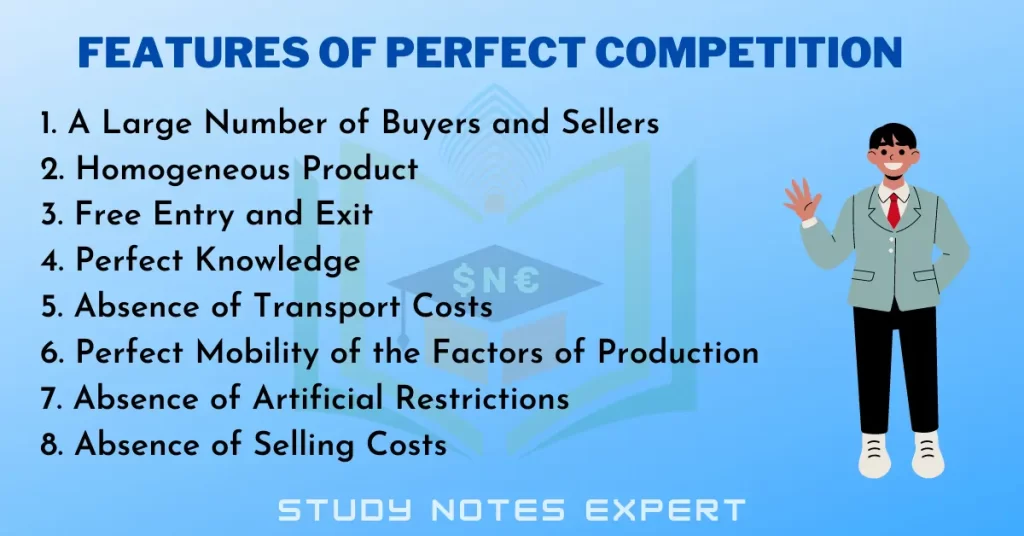
The following are the features of perfectly competitive market:
1. A Large Number of Buyers and Sellers
The first condition of perfect competition is the existence of many buyers and sellers otherwise, the market price cannot be affected by a single producer or purchaser who varies his supply of demand. Any single firm contributes only a small portion of its output concerning total output. In contrast, a single purchaser’s demand is only a small portion of the total demand.
2. Homogeneous Product
The production of items has to be according to the second condition of perfect competition. Products should be homogeneous. There will be no single seller that is superior to the other sellers. The products such as salt, wheat, cotton, coal, etc., are examples of homogeneous products. It is one of the main features of perfect competition.
3. Free Entry and Exit
Under perfect competition, the firms in the industry earn the expected profit, which can happen if there is no restriction on the firms regarding their exit from the industry or entry into the industry. Therefore, new firms will cater if there is more profit, which will contest the extra profit. On the other hand, less profit will result in quitting some firms where remaining firms will share the boosted gain.
4. Perfect Knowledge
There should be perfect knowledge of the market, the buyers and sellers, and they must be completely aware of the prices being offered and accepted. When buyers and sellers know the price, the market will have a uniform price.
5. Absence of Transport Costs
It is already knowledge that there are no transport services. If the rates are comparable and the cost is relative, then the customer must pay no expense for transportation.
6. Perfect Mobility of the Factors of Production
The flexibility of the production elements is essential for them to adjust their production to meet demand. If demand is more significant than supply, it will shift additional features into the industry which are out of the sector in a difficult circumstance. The movement of production elements is crucial for companies and the drive to reach equilibrium. It is the main features of perfect competition.
7. Absence of Artificial Restrictions
Sellers have the right to choose sellers to market their products to anyone, and buyers can purchase anytime from sellers. Both sellers and buyers have to be free of any form of discrimination.
8. Absence of Selling Costs
Because of the creation of homogeneous products from the companies, the expense of advertising and sales promotions is negligible in an ideal competition. Absence of selling costs are the perfectly competitive market features.
Assumptions of Perfect Competition
This analysis bases itself on the following assumption:
- The entry and exit without the restriction of the companies.
- The effectiveness of all firms is similar.
- Because of homogeneity in all aspects of production, customers can obtain them at consistent and uniform costs.
- Uniformity of cost curves for companies.
- Technology being similar and the manufacturing facilities of all the companies are similar.
- All firms have the best knowledge of price and output. It is the assumptions of perfect competition.
Major Advantages of Perfect Competition
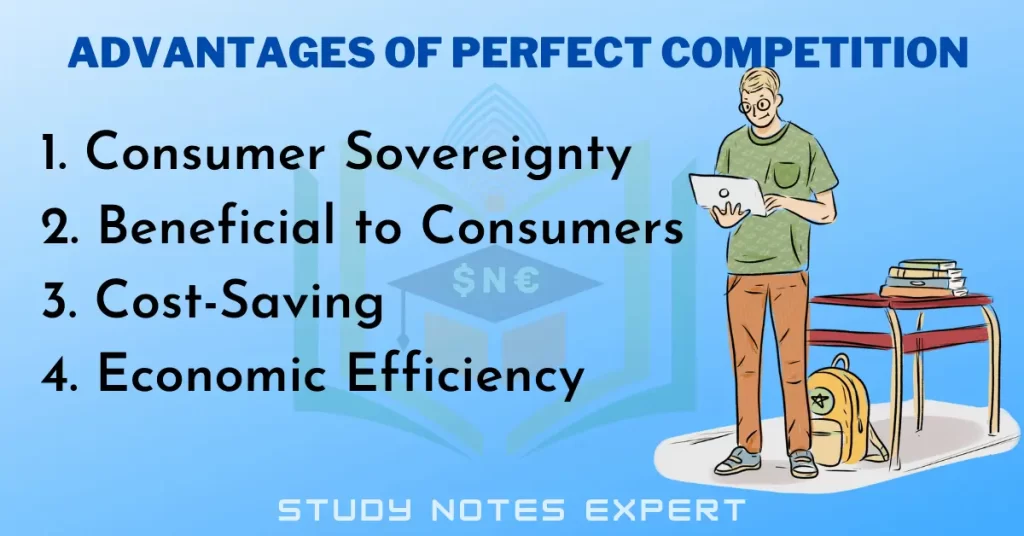
The following are the advantages of perfectly competitive market:
1. Consumer Sovereignty
Consumers dominate the perfectly competitive market. They are rational and have perfect knowledge about the conditions of the market. Due to this reason, consumers will never purchase products at a higher price.
2. Beneficial to Consumers
It is beneficial for the consumer that the price is equal to the minimum average cost in a perfectly competitive market. It the important advantages of perfect competition to the customers.
3. Cost-Saving
The wastage of resources is decreasing as the producers do not incur expenditure on advertising to promote sales. It is due to the perfectly competitive firms, which are price-takers and homogeneous products.
4. Economic Efficiency
The perfectly competitive firm attains the optimum level of functioning in the long run. It means that the firms achieve maximum economic efficiency in production. The firm’s actual output is equal to the optimum work; hence, there is no unused, idle, or surplus capacity. Economic efficiency is the specific advantages of perfect competition.
Extreme Disadvantages of Perfect Competition
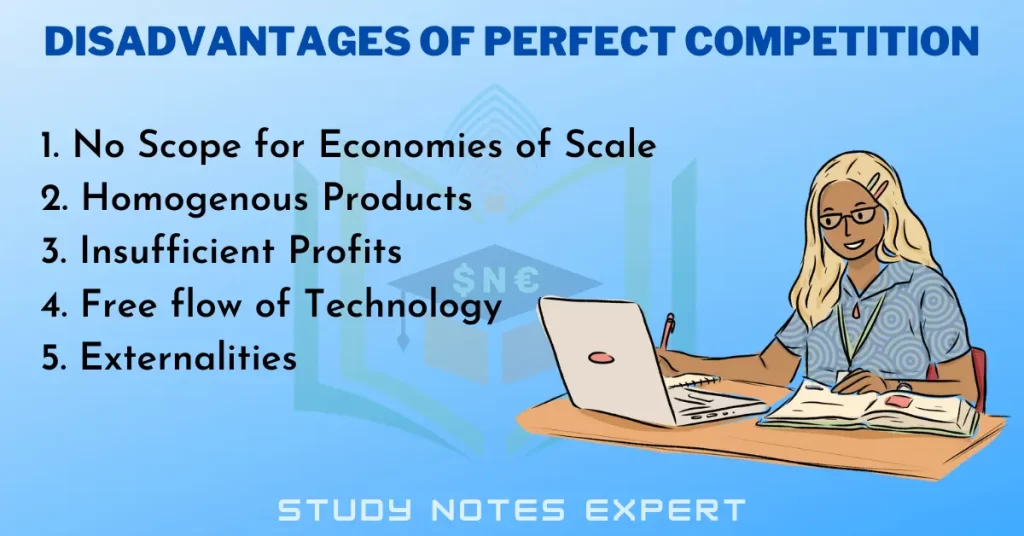
The following are the disadvantages of perfect competition:
1. No Scope for Economies of Scale
Due to the small amounts many small firms produce, there is no scope for economies of scale. Industries having high fixed costs are specifically improper for perfect competition. Due to this reason, perfect competition does not exist in the real world.
2. Homogenous Products
Consumers have fewer choices from boring identical products, whereas different products, such as clothing and cars, are essential in the industry. It is the main disadvantages of perfect competition as customers does not have variety to choose.
3. Insufficient Profits
Investment in R&D is helpful in the lack of supernormal profits, which is essential for the pharmaceutical industry requiring meaningful investment.
4. Free flow of Technology
Due to the unavailability of patents, there is no profit in developing new technology because other companies will use these technologies.
5. Externalities
The market would fail without the government’s interference due to expenses in production or consumption. The outside environment affects the market so it the major disadvantages of perfect competition.
The Determination of Price Under Perfect Competition
The typical market structure described by many sellers and buyers with no entry or exit for firms, similar goods and prices, and sellers and buyers with a complete understanding of the market’s conditions is a perfectly competitive market. Each seller provides a portion of the total supply; one buyer and seller can’t alter the market price. The intersection of demand-supply curves will determine the equilibrium value of the commodity in the optimal competition.
1. Market Demand
It’s the market demand for all industries with different costs. It’s the quantity required by each user or customer.
2. Market Supply
Market supply includes the amount supplied by each firm in the market. That is why market prices are set for the entire industry and provided to every individual company and every buyer.
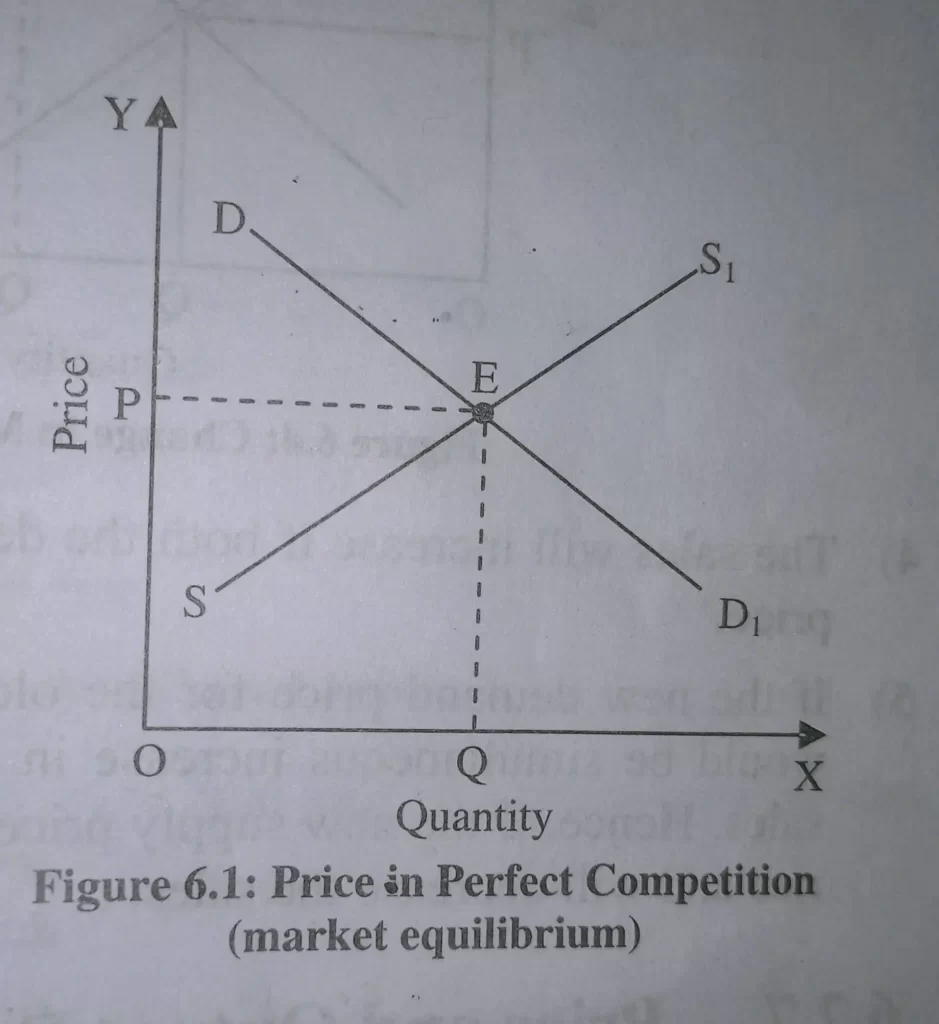
In Figure 6.1, The forces of demand and supply determine the ideal competition. Demand and supply are in equilibrium when the price decides at point E. Any changes in equilibrium are due to changes in the forces that drive supply and demand.
In a competitive market, a buyer is a price-taker, not a price-maker.
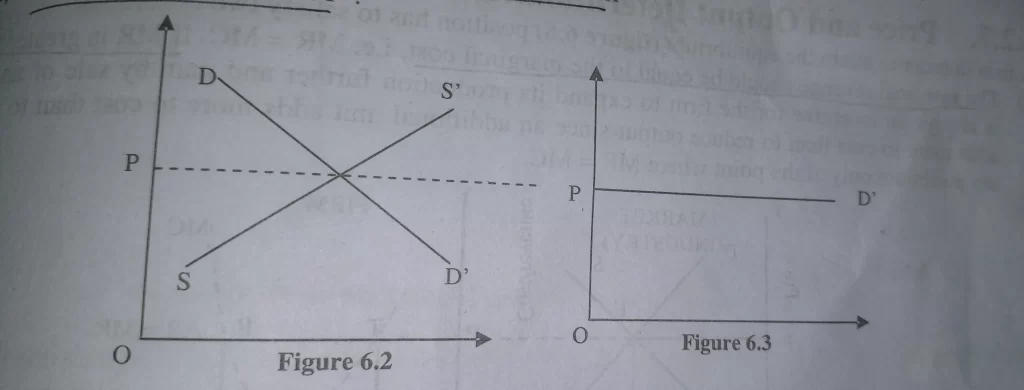
The difference between market demand and firm demand can seen in figures 6.2 and 6.3. In perfect competition, the market price structure and the intersection of supply and demand prices are fixed. The market chooses the price which has to be adhered to by the firm. If the product cost is set higher than ‘OP,’ then the company cannot sell any product when the price is below the ‘OP’ mark, and the other competitors will react to that, which will result in the decline of ‘OP.’
The firm’s pricing determination process and equilibrium in perfect competition are in figure 6.3. The company’s demand curve (D’) is horizontal at the rate determined by the market intersection of the supply and demand curves. This demand curve for the company is known as the average Revenue (AR) curvature because it sells its commodities as output units at the exact cost. The revenue generated by an intermediate unit should be the same as its cost. If the AR curve is neither rising nor falling, it is similar to that of the Marginal Revenue (MR) curve.
Any shift in market price is due to changes in market demand or the market’s supply. If the supply and demand of the commodity fluctuate in the marketplace, prices and quantities requested will also change.
- If demand rises, the prices will increase and reverse in figure 6.4. The market goes up, and the demand curve changes to the right from D to D1 while it remains the same supply. Because of the shift in “demand, prices rise from OP to OP1. Thus, the price increases from OQ to OQ1.
- Prices drop because of a rising supply, and reverse. It is in figure 6.5. The supply rises, and the resultant supply curve shifts opposite direction in the direction of S to S and vice versa, while the demand remains constant. Because of the change in supply, the price decreases from OP to OP1. Therefore, the price increases between OQ to OQ1.
- If there is a change within the demand curve, prices will decrease in the case of a supply curve that can be said to be elastic (flat). Prices will likely rise or fall more if the supply curve is not elastic (steep). If the price increase is more significant, then the increase in sales is lower. If the price increase is lower, the increase in sales is greater.
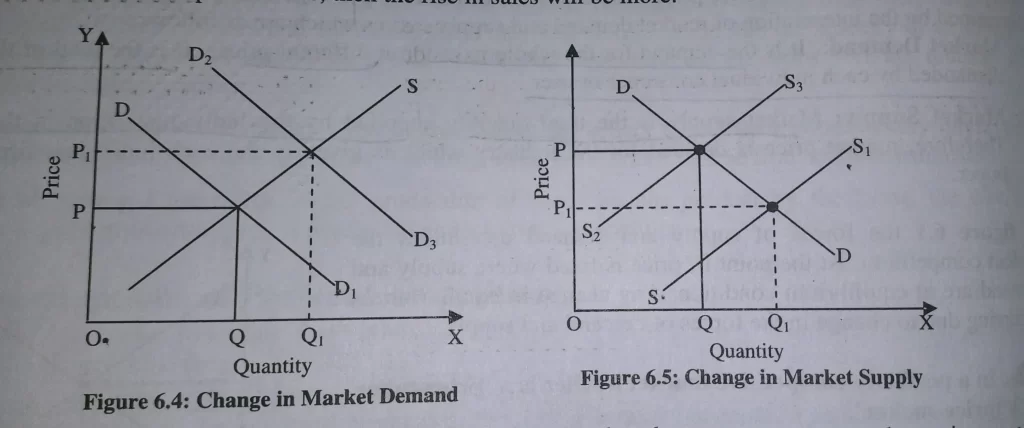
4. Sales will rise when both demand and supply grow, but there might be a decrease in the price.
5. If the price of demand for the equilibrium quantity is higher than the value at the time of supply, there will be a simultaneous rise in demand and a decrease in supply, thereby raising prices and driving up sales. Therefore, if the new demand price of the previous quantity is greater than the price of its new demand and the price rises, it will be a problem, and sales will fall.
What is Perfect Competition?
In perfect competition, there are a large number of small firms in the market. Each firm produces a homogeneous product and is a price taker. Firms can freely enter and exit the market. There is perfect information, meaning that buyers and sellers know all relevant information about the product being traded.
Who Benefits from Perfect Competition?
In perfect competition, there are many small businesses competing against each other. This means that there is little to no market power, and prices are determined by the market. Everyone in the market benefits from this, as there is more competition and lower prices.
What is the Strength of Perfect Competition?
There are many strengths of perfect competition. Some of these include:
1. Many buyers and sellers
2. Identical products
3. Perfect information
4. No barriers to entry or exit
5. Efficient allocation of resources
6. Dynamic consumer equilibrium

